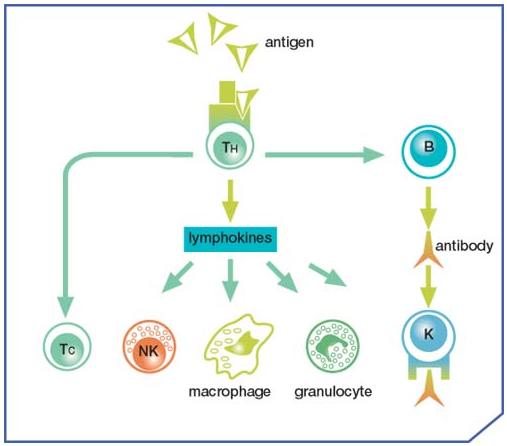|
Pathophysiology – how HIV causes disease
The immune system
The human immune system can be regarded as an organ concerned with destroying and eliminating from the body any organism, substance or particle that threatens the body’s integrity.
Like the heart or the brain, an effective immune system is essential to life. It differs from these organs, however, in having a wide variety of components dispersed throughout the body and circulating in the blood.
To mount an immune response, these various components must communicate and interact in a precisely orchestrated and organised way.
One component with a pivotal role in co-ordinating this is the CD4+ cell, or T-helper cell.
The CD4+ cell is the primary target of HIV.
The CD4+ cell, also known as the T-helper cell (TH), is a central component of the human immune response. CD4+ cells bear receptors on their surface, which allow them to pick up antigens, the specific molecules from the virus or other ‘foreign body’ that alerts the immune system to the presence of something dangerous. Once the CD4+cells have captured antigens, they help B cells to make antibodies, and they release lymphokines, chemicals that stimulate other varieties of immune cell to kill the invader.
-
Tc – cytotoxic T cells
recognise and destroy cells coated with antigens (the antigen may be deposited on the surface of a cell as the virus enters, making it a target for Tc activity)
-
NK – natural killer cells
use the cell-surface changes that result from viral infection to identify and kill infected cells
-
K – killer cells
can bind to antibodies, which ‘flag up’ infected cells for killer cells to destroy
-
Granulocytes
– can engulf and digest infected cells
-
Macrophages
– release chemicals that stimulate and control the actions of other effector cells, but also engulf and digest infected cells
HIV and the immune system
The details of how HIV infection damages the immune system are still being investigated.
Essentially, however, the impact of the virus results from the progressive depletion of CD4+ cells. HIV destroys these cells during the process of replicating itself. In addition, CD4+ cells that have been infected with the virus can be recognised by other immune cells, which can then destroy them.
Although the body continually produces CD4+ cells, it is eventually unable to keep pace with this destruction, and CD4+ cell numbers ultimately decline.
Without sufficient numbers of CD4+ cells, the immune system is unable to function effectively – this is the onset of immunodeficiency.
When AIDS develops, the body becomes vulnerable to rare malignancies and to serious infection from organisms that usually pose no threat to healthy people.
|





